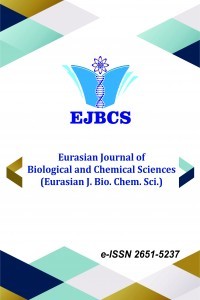Biyorafineri konseptiyle Rhodobacter sphaeroides O.U.001 ile biyolojik hidrojen ve bakteriyel karotenoid üretimi
Karotenoid, Hidrojen, Melas, Rhodobacter sphaeroides
Production of biological hydrogen and bacterial carotenoids with Rhodobacter sphaeroides O.U.001 in a biorefinery concept
Carotenoid, Hydrogen, Molasses, Rhodobacter sphaeroides,
___
- Chang S, Li J, Liu F. 2011. Continuous biohydrogen production from diluted molasses in an anaerobic contact reactor. Frontiers of Environmental Science and Engineering in China. 5(1):140-148. doi:org/10.1007/S11783-010-0258-2
- Cherubini F, Jungmeier G. 2010. LCA of a biorefinery concept producing bioethanol, bioenergy, and chemicals from switchgrass. The International Journal of Life Cycle Assessment. 15(1):53-66. doi:org/10.1007/S11367-009-0124-2
- Dursun N, Gülşen H. 2019. Biyohidrojen Üretim Yöntemleri ve Biyohidrojen Üretiminde Biyoreaktörlerin Kullanımı. Iğdır Üniversitesi Fen Bilimleri Enstitüsü Dergisi, 9(1):66-75. doi:org/10.21597/JIST.418445
- Gu Z, Deming C, Yongbin H, Zhigang C, Feirong G. 2008. Optimization of carotenoids extraction from Rhodobacter sphaeroides. LWT - Food Science and Technology. 41(6): 1082-1088. doi:org/10.1016/J.LWT.2007.07.005
- Kars G, Alparslan Ü. 2013. Valorization of sugar beet molasses for the production of biohydrogen and 5-aminolevulinic acid by Rhodobacter sphaeroides O.U.001 in a biorefinery concept. International Journal of Hydrogen Energy. 38(34):14488-14494. doi:org/10.1016/J.IJHYDENE.2013.09.050
- Kars G, Ceylan A. 2019. Hydrogen generation by Rhodobacter sphaeroides O.U.001 using pretreated waste barley. Cumhuriyet Science Journal. 40(2):414-423. doi:org/10.17776/CSJ.524612
- Kars G, Alparslan Ü. 2020. Unraveling optimum culture composition for hydrogen and 5-aminolevulinic acid production by Rhodobacter sphaeroides O.U.001. International Journal of Energy Applications and Technologies. 7(3):61-68. doi:org/10.31593/ijeat.738318
- Kars G, Demirel Kars M, Obalı İ, Emsen A, Gündüz U. 2020. Investigation of Antioxidant and Cytotoxic Effects of Biotechnologically Produced Carotenoids from Rhodobacter sphaeroides O.U. 001. Gümüşhane Üniversitesi Fen Bilimleri Enstitüsü Dergisi. 10(3):559-568. doi:org/10.17714/GUMUSFENBIL.597048
- Kars G, Gündüz U. 2010. Towards a super H2 producer: Improvements in photofermentative biohydrogen production by genetic manipulations. International Journal of Hydrogen Energy. 35(13):6646-6656. doi:org/10.1016/J.IJHYDENE.2010.04.037
- Keskin T, Hallenbeck PC. 2012. Hydrogen production from sugar industry wastes using single-stage photofermentation. Bioresource Technology. 112:131-136. doi:org/10.1016/J.BIORTECH.2012.02.077
- Kiokias S, Oreopoulou V. 2006. Antioxidant properties of natural carotenoid extracts against the AAPH-initiated oxidation of food emulsions. Innovative Food Science & Emerging Technologies. 7:132-139. doi:org/10.1016/J.IFSET.2005.12.004
- Liu S, Zhang G, Li X, Wu P, Zhang J. 2015. Enhancement of Rhodobacter sphaeroides growth and carotenoid production through biostimulation. Journal of Environmental Sciences. 33:21-28. doi:org/10.1016/J.JES.2015.01.005
- Motohashi N, Wakabayashi H, Kurihara T, Takada Y, Maruyama S, Sakagami H, Nakashima H, Tani S, Shirataki Y, Kawase M, Wolfard K, Molnár J. 2003. Cytotoxic and multidrug resistance reversal activity of a vegetable, ‘Anastasia Red’, a variety of sweet pepper. Phytotherapy Research. 17(4):348-352. doi:org/10.1002/PTR.1144
- Özgür E, Mars AE, Peksel B, Louwerse A, Yücel M, Gündüz U, Claassen PAM, Eroǧlu I. 2010. Biohydrogen production from beet molasses by sequential dark and photofermentation. International Journal of Hydrogen Energy. 35(2):511-517. doi:org/10.1016/J.IJHYDENE.2009.10.094
- Özsoy Demiriz B, Kars G, Yücel M, Eroğlu İ, Gündüz U. 2019. Hydrogen and poly-β-hydroxybutyric acid production at various acetate concentrations using Rhodobacter capsulatus DSM 1710. International Journal of Hydrogen Energy. 44(32):17269-17277. doi:org/10.1016/J.IJHYDENE.2019.02.036
- Sagir E, Alipour S, Elkahlout K, Koku H, Gunduz U, Eroglu I, Yücel M. 2018. Biological hydrogen production from sugar beet molasses by agar immobilized R. capsulatus in a panel photobioreactor. International Journal of Hydrogen Energy. 43(32):14987-14995. doi:org/10.1016/J.IJHYDENE.2018.06.052
- Uyar, B, Eroğlu İ, Yücel M, Gündüz U, Türker L. 2007. Effect of light intensity,wavelength and illumination protocol on hydrogen production in photobioreactors. International Journal of Hydrogen Energy. 32(18):4670-4677.
- Young A, Lowe G. 2001. Antioxidant and prooxidant properties of carotenoids. Archives of Biochemistry and Biophysics. 385(1):20-27. doi:org/10.1006/ABBI.2000.2149
- Yayın Aralığı: Yılda 2 Sayı
- Başlangıç: 2018
- Yayıncı: Muhammet DOĞAN
SARS-COV-2 enfeksiyonu olan hastalarda laboratuvar parametrelerin prognoz değeri
Kübra DANIŞ, Buse Nur BİNGÖL, Gökhan KARS
Thymoquinone Prevents Valproic Acid-Induced Nephrotoxicity in Rat Kidney
Sebile AZİRAK, Deniz TAŞTEMİR KORKMAZ, Sedat BİLGİÇ, Meltem ÖZGÖÇMEN, Mehmet Kaya ÖZER
Omar Mahmood MOHAMMED, Haci Ahmet DEVECİ, Gökhan NUR
Biochemical Laboratory Findings on COVID-19 Patients: Pathogen-Disease Relationship
Aysel GÜVEN, Ertugrul ALLAHVERDİ, Tülay ALLAHVERDİ, Meriç ÇOLAK
Effects of different nitrogen sources on invertase production by Aspergillus niger
Özden CANLI TAŞAR, Gani Erhan TAŞAR
Erol ATAY, Zeynel CEBECİ, Mehmet ÇELİK
Ayşen Yağmur KURŞUN, Burcin YALCİN, Merve GÜNEŞ, Ghada TAGORTİ, Bülent KAYA
